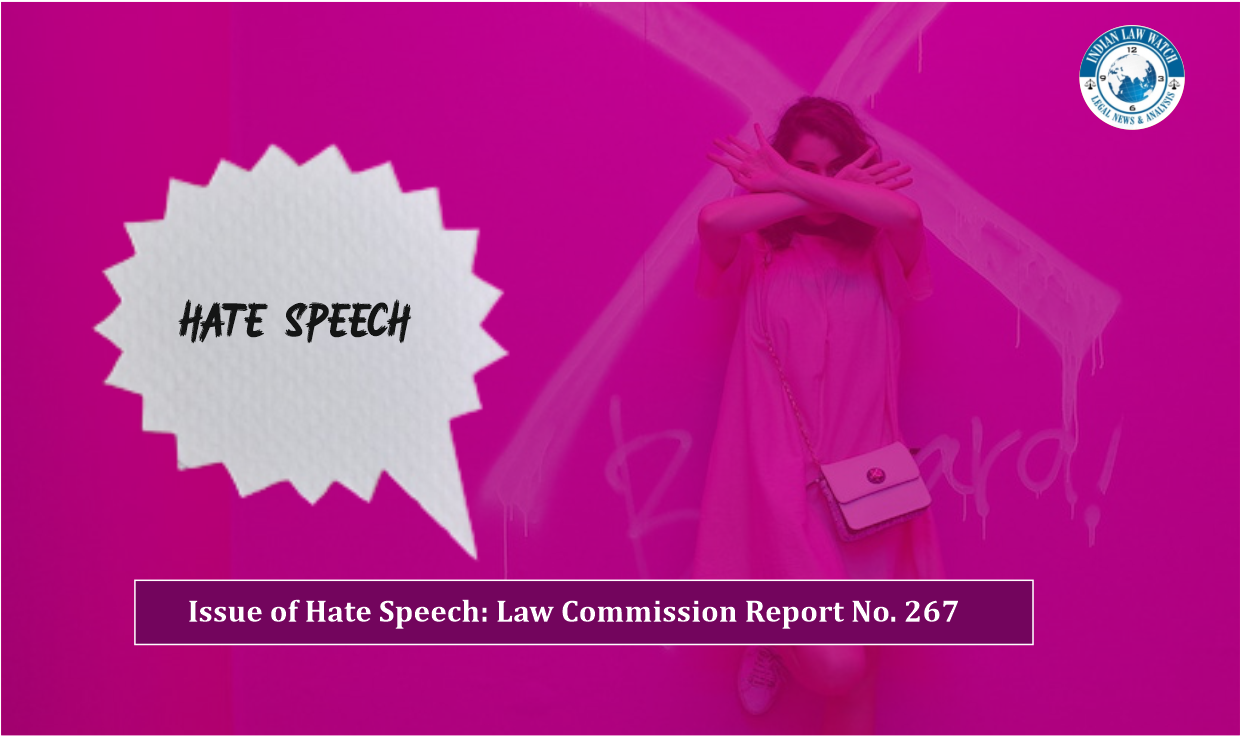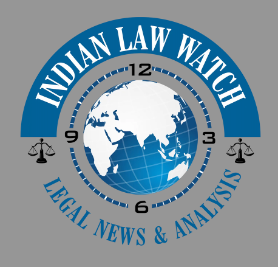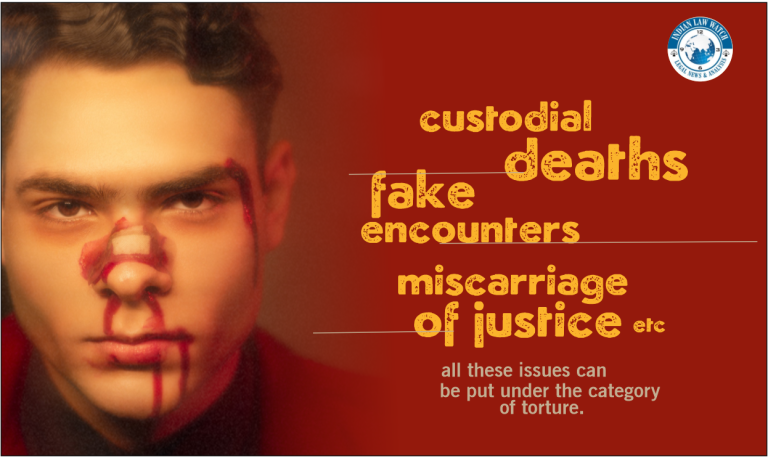
“Returning hate for hate multiplies hate, adding deeper darkness to a night already devoid of stars. Darkness cannot drive out darkness; only light can do that. Hate cannot drive out hate; only love can do that.”
Martin Luther King, Jr.
Understanding the term “Hate Speech”
Responsible speech is the essence of the liberty granted under article 21 of the Constitution. One of the greatest challenges before the principle of autonomy and free speech principle is to ensure that this liberty is not exercised to the detriment of any individual or the disadvantaged section of the society. In a country like India, with diverse castes, creed, religions and languages, this issue poses a greater challenge. Under International Human Rights Law, there is no universal definition of hate speech as the concept is still widely disputed with regard to freedom of opinion and expression, non-discrimination, and equality.
According to Merriam Webster dictionary, “hate speech is a speech expressing hatred of a particular group of people”.
Collins dictionary defines hate speech as “speech disparaging a group on the grounds of colour, race, ethnicity, nationality, religion, sex, sexual orientation, gender identity, or disability, or a person who identifies with such a group”.
As per the oxford dictionary, “hate speech is speech or writing that attacks or threatens a particular group of people, especially based on race, religion, or sexual orientation”.
Black’s Law Dictionary has defined it as “speech that carries no meaning other than the expression of hatred for some group, such as a particular race, especially in circumstances in which the communication is likely to provoke violence.”
Whereas the Cambridge dictionary describes hate speech as “public speech that expresses hate or encourages violence toward a person or group based on something such as race, religion, sex, or sexual orientation (the fact of being gay, etc.).”
the Supreme Court, in Pravasi Bhalai Sangathan v. Union of India (2014), described hate speech as “an effort to marginalise individuals based on their membership in a group” and one that “seeks to delegitimise group members in the eyes of the majority, reducing their social standing and acceptance within society.”
To provide a unified framework for the UN system to address the issue globally, the United Nations Strategy and Plan of Action on Hate Speech defines hate speech as…“any kind of communication in speech, writing or behaviour, that attacks or uses pejorative or discriminatory language with reference to a person or a group on the basis of who they are, in other words, based on their religion, ethnicity, nationality, race, colour, descent, gender or other identity factors.”
European Convention on Human Rights: Similarly, Article 10(2) of the European Convention on Human Rights, provides reasonable duties and restrictions during the exercise of one’s fundamental right to free speech.
International Covenant on Civil and Political Rights (ICCPR): As per Article 19(3) of the ICCPR, the right of freedom of speech can be regulated in order to honour the rights of others and in the interest of public order, public health or morals.
Article 20(2) of the ICCPR also declares that any advocacy of national, racial, or religious hatred that constitutes incitement to discrimination, hostility, or violence shall be prevented by law.
Recent Developments Around Hate Speech
- Reference from the Supreme Court of India: The Supreme Court in the case of Pravasi Bhalai Sangathan v. Union of India, AIR 2014 SC 1591, observed that the issue of hate speech deserves deeper scrutiny by the Law Commission of India and also to consider, if it deems proper, defining the expression hate speech and make recommendations to parliament to strengthen the election commission to curb the menace of hate speech irrespective of whenever made.”
- High case filling rate with a low conviction rate: According to the National Crime Records Bureau data, cases filed under Indian Penal Code (IPC) Section 153A (promotion of enmity between different groups on grounds of religion, race, place of birth, residence, language) saw almost 500 percent increase between 2014 and 2020. The number of cases from 323 in 2014 raised to 1804 in 2020. On the other hand, the conviction rate of only around 20% in ‘hate speech cases in the year 2020 is almost 1/3rd of the conviction rate of all cognizable IPC crimes. In other words, the conviction rate of ‘hate speech’ related cases is among the lowest of all IPC crimes.
Freedom of Speech and Hate Speech
Hate speech has not been defined in any law in India. However, legal provisions in certain legislations prohibit select forms of speech as an exception to freedom of speech. Article 19(1) (a) of the constitution of India guarantees the right to speech and expression. But there cannot be any right that is injurious to the community as a whole. If people were given complete and absolute liberty without any social control the result would be ruined (Wills- Constitutional Law and the United States, 477).
Justice Patanjali Shastri in A.K Gopalan v. State of Madras AIR 1951 SC 21 observed, “man as a rational being desires to do many things, but in a civil society his desires have to be controlled, regulated and reconciled with the exercise of similar desires by the other individuals.”
The Constitution acknowledges that liberty cannot be absolute or uncontrolled and makes provisions in clauses (2) to (6) of article 19 authorising the State to restrict the exercise of the freedom guaranteed under that article within the limits specified in those clauses. Thus, clause (2) of article 19, as subsequently amended by the Constitution (First Amendment) Act, 1951 and the Constitution (Sixteenth Amendment) Act, 1963, enabled the legislature to impose reasonable restrictions on the exercise of the right to freedom of speech and expression in the interests of (i) the security of the State and sovereignty and integrity of India, (ii) friendly relations with foreign States, (iii)public order, (iv) decency or morality, or in relation to contempt of court, defamation or incitement to an offence.
Legal Provisions of Hate Speech In India
At present India have the following legislations that deal with hate speech, namely:-
- The Indian Penal Code, 1860
- Section 124A IPC penalises sedition
- Section 153A IPC penalises ‘the promotion of enmity between different groups on grounds of religion, race, place of birth, residence, language, etc., and doing acts prejudicial to the maintenance of harmony.
- Section 153B IPC penalises ‘imputations, and assertions prejudicial to national integration.
- Section 295A IPC penalises ‘deliberate and malicious acts, intended to outrage religious feelings of any class by insulting its religion or religious beliefs.
- Section 298 IPC penalises ‘uttering, words, etc., with deliberate intent to wound the religious feelings of any person.
- Section 505(1) and (2) IPC penalise publication or circulation of any statement, rumour, or report causing public mischief and enmity, hatred, or ill-will between classes.
- According to Section 8 of the Act, a person shall be disqualified from contesting the election if he is convicted of including in acts amounting to the illegitimate use of freedom of speech and expression.
- Section 123(3A) and section 125 prohibit the promotion of enmity on grounds of religion, race, caste, community, or language in connection with an election as a corrupt electoral practice and prohibits it.
- The Protection of Civil Rights Act, 1955
- Section 7 penalises incitement to, and encouragement of untouchability through words, either spoken or written or by signs or by visible representations or otherwise.
- The Religious Institutions (Prevention of Misuse) Act,1988
- Section 3(g) prohibits religious institution or its manager to allow the use of any premises belonging to, or under the control of, the institution for promoting or attempting to promote disharmony, feelings of enmity, hatred, ill-will between different religious, racial, language or regional groups or castes or communities.
- The Cable Television Network Regulation Act, 1995
- Sections 5 and 6 of the Act prohibits transmission or re-transmission of a programme through a cable network in contravention to the prescribed programme code or advertisement code. These codes have been defined in rules 6 and 7 respectively of the Cable Television Network Rules, 1994.
- The Cinematography Act, 1952
- Sections 4, 5B, and 7 empower the Board of Film Certification to prohibit and regulate the screening of a film.
- The Code of Criminal Procedure, 1973
- Section 95 empowers the State Government, to forfeit publications that are punishable under sections 124A, 153A, 153B, 292, 293, or 295A IPC.
- Section 107 empowers the Executive Magistrate to prevent a person from committing a breach of the peace or disturbing the public tranquillity or to do any wrongful act that may probably cause a breach of the peace or disturb the public tranquillity.
- Section 144 empowers the District Magistrate, a Sub-divisional Magistrate, or any other Executive Magistrate specially empowered by the State Government on this behalf to issue the order in urgent cases of nuisance or apprehended danger. The above offences are cognizable. Thus, have serious repercussions on the liberties of citizens and empowers a police officer to arrest without orders from a magistrate and without a warrant as in section 155 CrPC.
Criteria for Hate Speech
Not all types of speeches are hate speech. Only certain types of speeches are presumed to be hated in nature. There are certain parameters through which one can distinguish between speech, discussion, advocacy, and incitement. The Supreme Court in the matter of Shreya Singhal v. Union of India AIR 2015 SC 1523, had differentiated between three forms of speech, discussion, advocacy, and incitement. It was held by the Court that a speech can only be limited on grounds of exceptions mentioned in article 19(2) when it reaches the threshold of incitement. All other forms of speech, even if offensive or unpopular have to be protected under article 19(1) (a). Incitement is the key to determining the constitutionality of a restriction on free speech.
Many parameters have been developed by the courts of different jurisdictions to identify hate speech. Some of them are summarised s below:
- The extremity of the speech
A speech can be termed hate speech if it is offensive and it projects an extreme form of emotion. The supreme court of the United States in the case chaplinsky v. New Hampshire, 315 U.S 568(1942) held that the expressions of advocacy and discussion of sensitive and unpopular issues have been termed ‘low-value speech’ unqualified for constitutional protection.
- Incitement
The element of incitement to discriminate is the basic factor of hate speech. A speech can be classified as hate speech if it has an intention to incite the public to discriminate the others based on race, caste, gender, religion, etc. the supreme court of India in Shreya Singhal v. Union of India observed that the speech must amount to incitement in order to be restricted. It is important to mention here that incitement to not only violence but also discrimination has been recognized as a ground for interfering with freedom of expression.
- Status of the author of the speech
The European Court of Human Rights (ECtHR) has recognized that position of the author of the speech is important in determining the legality of limitations imposed by the State. The Supreme Court in Pravasi Bhalai Sangathan v. Union of India AIR 2014 SC 1591 was approached to sanction hate speech. The petitioners sought the court’s intervention to declare “hate speeches” delivered by elected representatives, and political and religious leaders as unconstitutional. The petition was specifically addressed to the people who held power to influence society on a large scale. The Court recognizing the negative impact of hate speech referred the matter to Law Commission for an in-depth examination.
- Status of the victim of the speech
The status of the targeted audience is also important to determine whether the speech can be restricted or not. The limits of acceptable criticism are wider for a politician as such than regard a private individual.
- Potentiality of the speech
The potentiality of speech and how much impact it has on the minds of the public is also an important element. In Ramesh v. Union of India, AIR 1988 SC 775 Supreme Court examined the validity of the restriction based on the potential of the movie to impact the audience.
- Context of the speech
Not all speech is hate speech. The context of the speech determines the permissibility of the speech.
Test For Restraining the Freedom of Speech And Expression
International human rights law developed a three-part test that determines whether a particular type of speech should be curtailed or not. The following standards should be satisfied before curtailing the human right:
- Prescription by law: as per this rule, the restriction imposed must be prescribed by law. The means by which the right is curtailed should be passed through the appropriate procedures and through explicit provisions of the law.
- Legitimate aims: The measure must directly satisfy a legitimate aim.
- Necessity and proportionality: there must be a need for such a measure. The restriction cannot be imposed for any reason. There should be an urgent need to restrict any rights. Also, the restriction must not do any more damage to the right than is necessary to meet its aim.
Judicial Perspective on Hate Speech
The Supreme Court, in State of Karnataka v. Praveen Bhai Thogadia (2004), emphasised the need to sustain communal harmony to ensure the welfare of the people. In the Pravasi Bhalai Sangathan case, the Supreme Court pointed out the impact hate speech can have on the targeted group’s ability to respond and how it can be a stimulus to further attacks. In G. Thirumurugan Gandhi v. State (2019), the Madras High Court explained that hate speeches cause discord between classes and that the responsibility attached to free speech should not be forgotten.
In Amish Devgan v. Union of India (2020), the Supreme Court held that “hate speech has no redeeming or legitimate purpose other than hatred towards a particular group”. In the matter of Arup Bhuyan vs the State of Assam, The Court held that a mere act cannot be punished unless an individual resorted to violence or incited any other person to violence. In the case of S. Rangarajan Etc. vs P. Jagjivan Ram, the Court held that freedom of expression cannot be suppressed unless the situation so created are dangerous to the community/ public interest wherein this danger should not be remote, conjectural, or far-fetched. There should be a proximate and direct nexus with the expression so used.
Non-legal Measures to Tackle Hate Speech
To address the issue of hate speech many non-legal measures should be taken. Some of them are as follows:
- Television dramas that promote harmony between warring communities should be promoted.
- The religious heads should be involved to build empathy across religions so that the social tension can be reduced.
- Strategic interventions should be made by the government especially in the context of social media so that the dissemination of hate speech and mob mobilisation can be monitored.
- To aware people to stop spreading harmful rumours.

India is culturally rich country. Any attempt to allow hate speech can marginalise classes and groups of persons who are already in a minority due to their race, language, and religion. The already existing laws are not sufficient to deal with instances of hate speech. The law commission in its 267th report made recommendations for provisions for prohibiting incitement of hate speech and prohibiting causing fear, alarm, or provocation of violence through such speech. The report was published in the year 2017 although no development so far. The idea of criminalization of hate speech and how the existing laws look at it needs attention for bringing the right change. Since it is entrenched in the constitutional right of freedom of speech and expression, “hate speech” has been manipulated by many in different ways to achieve their ulterior motive under the garb of such right and the law courts in absence of clear provisions in IPC, are not able to prosecute hate speech charges brought before them with success. There is no general legal definition of hate speech. The law in this regard is awaiting development.





